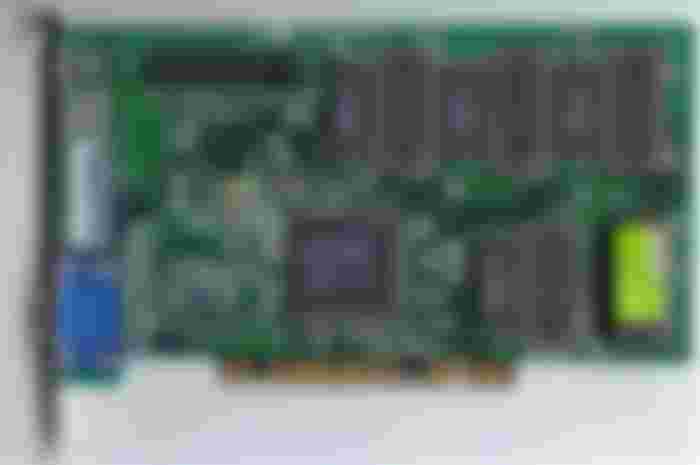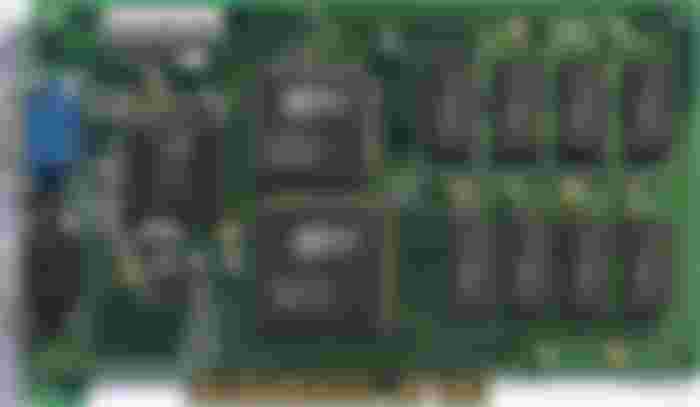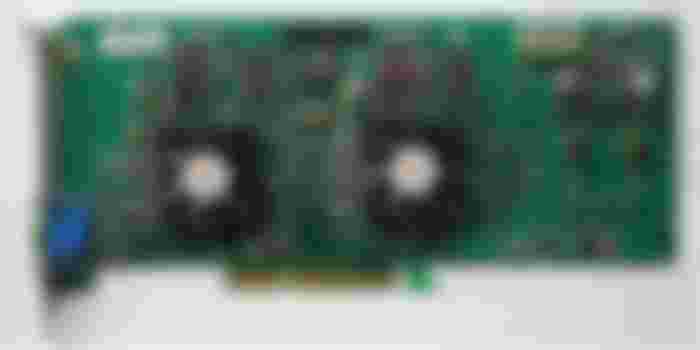3dfx was a corporation manufacturing graphics cards in the 90's. 3dfx was one of the first corporation to offer 3D capable graphics chips. This article will explain, why 3dfx failed, from a new perspective. People usually explain the bankruptcy of 3dfx due to some bad acquisitions of other corporations, and slow development. This is true, but these things are only the symptoms, and not the reason of the downfall.
1995
S3 introduced the Virge graphics card in 1995. S3 was an old player on the video market, they had various graphics chips, and they were considered high-end. S3 was the first corporation to produce fast PCI graphics chips with graphics acceleration, they have released the world's first real 3D card in 1995. The S3 Virge supported up to 4 MByte RAM, supported DirectX, the first versions of Direct3D, and they also supported 3D acceleration.

The strategy of S3
S3 was ahead of the market, they was thinking to make 3D-capable graphics cards, but there was basically nobody who made real 3D-capable graphics accelerators previously. There was 3D accelerators from smaller corporations, however, they were too weak or incompatible. They was very huge cards, and S3 wanted to make a very cheap card, without needing special separate chips or controllers. The Virge was cheap, flexible enough to be compatible with the upcoming DirectX standard in Windows 95, and when S3 released it, there was petty much no competition. The card became a mass-card.
3dfx Voodoo
After the release of the Virge, competitors also started to develop their graphics chips. Corporations such as nVidia, ATi (later became part of AMD), 3Dlabs, SiS, Intel, NEC, Matrox, PowerVR, Number9, Cirrus Logic, Trident, Neomagic, were releasing their 3D-capable cards in the following years as well. One of the first succesfull competitor to the S3 Virge was the Voodoo1 from 3dfx. The Voodoo1 had 4 MByte RAM, but it had no 2D functions. This means, the system required a normal graphics card as well. And the 3D games were running on the Voodoo1, but the operating system was using the normal 2D card to work.

The success of Voodoo1
Despite of needing a separate graphics card to work, the Voodoo1 became very popular. It was faster than S3 Virge and a little bit faster than nVidia's first NV1 chip, and was faster and had better picture quality than the Matrox MGA Mistyque. Voodoo1 had its own 3D API, called Glide. Besides this, they supported Direct3D and OpenGL as well. The D3D and OpenGL support however wasn't full. This was not possible due to the card wasnt an actual video card, just an expansion card. So mostly only the AAA games excelled on the Voodoo1, and the Voodoo1 was not able to pump out as much sale numbers as the S3 Virge. At this time, the Virge was about 2 years old anyway, so it was not that hard to beat it. However, people still used the Virge as a 2D card, and for non-AAA games based on D3D, the Virge was a better choice.
The Voodoo1 starts aging
The 3dfx Voodoo1 took the crown from S3, and it offered almost three times bigger performance than the Virge when running AAA games on it. However the card started aging very quickly, after nVidia released the Riva 128 (in 1997), and then 3Dlabs released the Permedia 1 and the other corporations listed above, also entered to the market. 3dfx Voodoo1 was not that good buy any more. It still had support from AAA gamers, but for example, a Riva 128 was a better buy - as it was offering 2D support, good Direct3D and OpenGL drivers, and similar speed to 3dfx.
3dfx Voodoo Rush: a 2D+3D card
3dfx started to work on a video card that was capable of running both 3D and 2D payloads, however they was not ready yet. They came up with a new plan. They have started developing a card, called Rush. They have used a competitor (AT3D) chip for 2D and then they have added two modified Voodoo chips on the card. The Voodoo was implemented from two chips alone, and then a separate 2D chip with the AT3D, which actually had a working, but disabled 3D core, resulted in a card that was too expensive to make. The performance was 25% lower than the performance of the previous Voodoo1. Even Glide based games were running too slow on it, as those were optimized for an at least Voodoo1-ish performance. To develop the Voodoo Rush, 3dfx had to reallocate some of its engineers to work on the Rush, delaying the work their first normal video chip. The lost time was critical.
1997 and 1998
As the Voodoo rush failed the market, and the Voodoo1 started to lose the market quickly, and they still had no 2D+3D chip ready, 3dfx had to come up with something fast. Competitors already created the next generation of cards. 3Dlabs came out with the new Permedia 2, nVidia was able to release the Riva TNT. SiS entered the market with its first 3D card, the SiS 6326, Matrox came up with the G200. Cirrus Logic released the Laguna 3D, Intel released its first 3D accelerator card, the i740. ATi released more refined versions of their Rage cards, boosting from underdog-class to the mid-range. All the competitors came out from the bush with their own video cards with 3D acceleration, and the speed was either comparable with Voodoo, and some of the earlyer competitors had cards two times faster than the Voodoo1.
Voodoo2
3dfx decided to release a new, complex card based on the previous Voodoo architecture. The Voodoo2 was created by using 3 chips. They have doubled the texture processing unit on the card, which was a separate chip. Each chip had its own dedicated memory. This was inefficient. The card was very complex, and was barely able to maintain the speed of the new competitors. Glide compatibility saved the card, as some of the AAA games still had Glide support, which made the 3dfx card very fast in these games. However, creating this card required engineers. And again, the engineers working on the corporations real graphics chip, had to be reallocated to work on the Voodoo2, in order to create this product.
Voodoo Banshee
The Voodoo Banshee was the first real graphics chip of 3Dfx. This implemented the 2D and 3D functionalities in one chip, and had better compatibility with non-AAA games as well. However this chip was in multiple years of delay due to the development of the extremely complex cards (Voodoo Rush and Voodoo 2). 3dfx cards were only able to produce 16 bit colors, at this time, all the competitors were able to do 24 or 32 bit rendering. The Voodoo banshee was limited to textures with size 256x256, the competitors were able to do 512x512 or even bigger textures. The performance of the card was weak. 3dfx was forced to compete with the previous generations of no-name OEM cards, such as the i740 or with newer OEM cards with strong 3D capabilities, such as 3dlabs Permedia2.
Buying STB
3dfx accoused their contractors for the fiasco of the Rush card. The image quality of the Voodoo Rush were bad, even in 640x480, the screen was blurry, unless the refresh rate was set to 60 Hz. The initial drivers were bad: 9 from 10 game from the time didn't even started on the card with the first drivers. Even the Glide support was missing in the initial driver release. The games able to run, were having minor issues. 3dfx decided to buy the manufacturer STB, and cut contracts with other manufacturers. Similarly to nowadays, corporations like nVidia didn't manufacture video cards by themself, instead, they sold the chips and blueprints. This caused 3dfx to lose some of its potential markets, STB started to accumulate huge losses from producing 3dfx cards only, as well (losing their previous partners).
Voodoo 3
3dfx was two years beyond, the tables were flipped. Once the king of AAA games, now it was forced to fight in the low-end. 3dfx quickly needed to refresh the chip. The new card was the Voodoo3. It was released in 1999. The engineers were not able to implement 32 bit rendering, or large texture support. The card was still limited to 16 MByte of video RAM. The AGP connector of the card was not able to work with the modern AGP signaling. Cards from competitors were running circles around the Voodoo3. However, the drivers of nVidia and ATi were a little bit more demanding, and only worked properly above Pentium3 class computers. 3dfx had drivers working well on Pentium-1 class computers, saving some of the market for 3dfx, allowing 3dfx to spare enough money to release a new family of cards.
Voodoo 5
The final updated chip of 3dfx was the chip for Voodoo4/Voodoo5. These cards use a refined Voodoo3 chip with support for larger textures, and the chip supported 32 bit. However, the Voodoo4 card was barely faster than the Voodoo3. The Voodoo5 used two chips, each had its own separate memory. The Voodoo5 was still not fast enough to catch up with the fastest chips from nVidia and ATi, yet due to the complex dual-cpu design, it was too expensive. 3dfx bankrupted after releasing the Voodoo5. The company was acquired by nVidia.

Everything went wrong
3dfx made two big mistake right after each other. The Voodoo rush was a market failure, the Voodoo2 was an unnecessary product. The development of these two cards delayed the Banshee almost two years. Due to the rapid development of the early 3D accelerators, this was enough time for every other brand to create better cards than 3dfx. 3dfx also failed to find market for their accelerators, they had almost no OEM partners, and they tried to sell the cards directly to the end-users. Smaller corporations found alternative business models, such as offering graphics chips to be integrated onto motherboards (SiS, S3). 3Dlabs started to focus on the CAD graphics market. PowerVR initially brought 3D acceleration to ARM chips and mobile phones. ATi got acquired by AMD to create integrated chips for AMD processors, but they still producing dedicated graphics cards as well. Almost all of the smaller manufacturers survived - even if they was acquired, they was bought by a big fish, and most of the corporations in this article are continuing to create graphics processors in some forms. Traditional PC graphics cards nowdays being made with nVidia and AMD (ATi) chips, most of the others are creating integrated graphics chips for ARM processors running under the Android platform.
Similarities of 3dfx and S3
The article was beginning with the story of S3. When we compare the strategy of S3 with 3dfx, we can see why 3dfx bankrupted, and why S3 still producing graphics chips to this day (as a subsidiary at VIA). S3 and 3dfx faced basically the same problems shortly after releasing their first graphics cards. The first similarity is producing the strongest hardware, but suddenly becoming totally obsolete just within two years. The second similarity is being very lucky. The luck of 3dfx was the good support for early AAA games, and the luck of S3 was the good support for non-AAA games.
What S3 did instead
3dfx attempted to keep the AAA game throne by desperately releasing newer iterations of the aging Voodoo1 architecture in the form of Voodoo Rush and Voodoo2. This resulted in a two year delay in their actual product line. S3 was an old rider in the business. They were producing graphics cards since 1991. S3 knew the importance of integration from the beginning, therefore their first 3D accelerator was a one-chip release. When S3 released the Virge, they have released a cheap and capable single-chip solution.
Focusing on the new generation
S3, similarly to 3dfx, started to work on the new chip after releasing their first PC 3D accelerator chip. S3 was faced with similar problems as 3dfx after releasing the cards, the card quickly became obsolete. However, 3dfx reallocated large number of engineers from the upcoming products to keep the older hardware lines alive. S3 didnt do this. S3 followed a different strategy. Instead of doing actual development on the old card, they have decided to do minimal development on the hardware. These were mostly developments they have to do on their new chips anyway.
The successful strategy of S3
S3 followed a minimalist maintenance strategy with the Virge product line. They have released upgraded versions from the chip, manufactured on much smaller manufacturing process. This requires only tiny efforts, but allowed the clock speeds of the new chip to be rised drastically. They have researched the AGP port, which they had to research for their new upcoming hardware generation anyway. Then they have modified the chip so it was able to handle 8 MByte of video memory on the card. The new hardware family was called S3 Trio3D. This was about twice as fast as the original Virge, was available on the new AGP port, and was just a tiny little bit faster than the Voodoo1, yet it was compatible with more games. Whith this product, which had no significant costs to produce, they was able to keep the previous generation of their card still in the game, without having to reallocate significant numbers of engineers from their new product line. Its not hard to realize, the successful strategy for 3dfx would been similar: minimal refining of the Voodoo1 chipset to smaller manufacturing node, rising the clock speeds, and adding 8 MByte of RAM.
The S3 Savage 3D
The new product was released in 1998, and was called S3 Savage 3D. The card was released about the time when the Voodoo Banshee was released. However, the Savage 3D was really a new era compared to the previous generations. The Banshee was still supporting only 16 bit rendering and small texture sizes, the Savage 3D already had support for larger textures and 32 bit colors. In 1999, both 3dfx and S3 upgraded their product lines. S3 released the new Savage 4, and 3dfx released the Voodoo 3. Both the Voodoo3 and the Savage4 got similar upgrade (stronger multitexturing capabilities) but the S3 hardware was modern enough to pull the multiple year long minimalist-maintenance strategy again, while they are focusing on their new hardware development. The technology lag of 3dfx was too big, and 3dfx vanished.
From a business aspect
The best paying business strategy is not to allocate significant research to save an obsolete business model. Minimalist tuning and cost-cuts are the best way to treat a phasing-out product. The creative force must be channeled into creating newer products. The new product must be simple, capable, cheap but profitable, and must be based on actual market research, not on vague ideas.
edit: I refactored this article in 2023 december a little bit, because it was in front of online searches, but it was full of inaccuracies.



Very important information for us. Thank you for post this artical. Thank you https://read.cash/@Geri